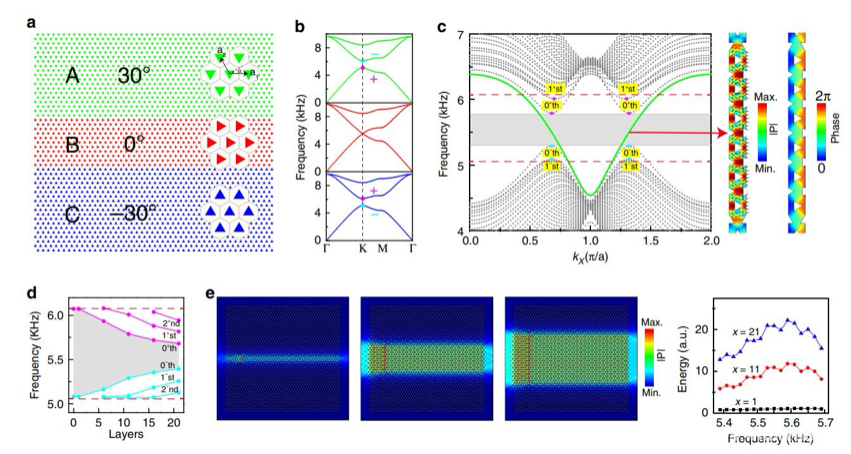Constructing a heterostructure with sonic crystals that contains valley index, Liu Zhengyou’s team achieves a valley-locked acoustic topological waveguide transport. This research, entitled Valley-locked waveguide transport in acoustic heterostructures, was published in Nature Communications. Wuhan University is the sole signatory, with doctoral graduate Wang Mudi as the first author and Prof. Liu Zhengyou as the corresponding author. Authors of this article also include Wen Zhouyi and Bi Liya, graduates of the 2015 class of the School of Physics and Technology, Wuhan University and Prof. Qiu Chunyin and Ke Manzhu.
Valley pseudospin, labeling the pair of energy extrema of dispersion relation in momentum space, has attracted attention because of its potential as a new degree of freedom in manipulating electrons or classical waves. In this study, by designing a sandwich-like heterostructure with three SCs containing valley indexes (Fig.1), a topological waveguide with valley-locked guiding states is obtained. This waveguide state has a gapless dispersion and valley-locked propagating direction with anti-scattering capability for barrier-free propagation. Compared with the simple two-phase structures with a topological interface state, the three-phase heterostructure with a topological waveguide state is thicker, offering high flux and more flexibility for interacting with existing acoustic devices and applications. Such heterostructures may serve as versatile new devices for acoustic wave manipulation, such as acoustic splitting, reflection-free guiding and energy converging. (Fig.2)

Fig. 1: heterostructure and the topological valley-locked waveguide states

Fig. 2: Valley-locked converging
At the same time, Liu Zhengyou's team and their collaborators have made important advances in the research of acoustic topological insulators, achieving the acoustic topological insulator induced by pseudospin-orbit coupling and taking spin Chern number as its topological invariant. On the surface of the single sonic crystal phase, a spin-momentum locked helical edge state is observed. The intrinsic spin-orbit coupling of the system shows the breaking of the spin conservation, which leads to the spin reversal effect of the edge state in the propagation process. The results were also published in Nature Communications.
The above research was funded by the National Natural Science Foundation of China (General Program and Major Program) and the National Key Research and Development Project.
Paper link:https://www.nature.com/articles/s41467-020-16843-z
https://www.nature.com/articles/s41467-020-17039-1.
Written by: Zhang Yifei
Rewritten by: Chen Muying
Edited by: Wu Buer, Sylvia and Hu Sijia